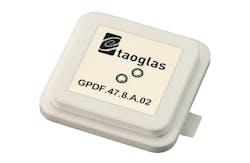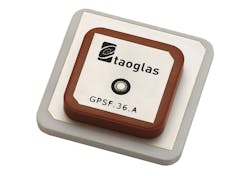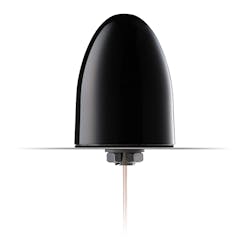Antenna, Technology Advances Merge to Drive Precision Location
This article is part of the TechXchange: Antenna Design 101
Download this article in PDF format.
The market for more accurate location capabilities has never been hotter. As companies dream of new applications for the Internet of Things (IoT) and other use cases, knowing the absolute location of an object or the relative location of an object in relation to another object, is becoming increasingly critical.
Imagine trying to quickly find a specific package in a pile of similar-looking boxes or delivering a pesticide to only certain plants in a vast field of plants. In cases like these and hundreds of others, including drone deliveries, supply-chain logistics, and the use of autonomous vehicles, accuracy is becoming a critical component that can dictate the success or failure of an initiative.
There’s a missing link, however, in many of today’s location technologies. A wealth of technologies can provide location accuracy to a dozen or so meters, and GPS within a few feet. But for a growing list of business cases, close isn’t close enough. Accuracy matters, and thus companies need a whole new approach for the accuracy conundrum, for both outdoor and indoor applications. Antennas are emerging as a key part of the equation in driving the market toward more precise location accuracy.
Outdoor Location: Multiband to the Rescue
Standard location capabilities have served the industry well over the past several decades, with the big beneficiary being vehicle navigation systems and smartphone mapping. Other applications like precision agriculture, precision construction, autonomous or assisted vehicles, and others demand much more accurate positioning, oftentimes within a few centimeters. Centimeter-level capabilities are being made possible through emerging technologies in GNSS receivers and high-quality antenna systems.
Current location solutions generally work in the GPS L1 band, in the 1500- to 1600-MHz range. To achieve high-precision absolute location accuracy requires the use of multiple RF frequencies. Location error comes from ever-changing signal delays in the atmosphere, and by listening to signals from the same satellite at more than one frequency, these errors can be removed. Such frequencies are commonly referred to in the GPS system as L1, L2, and L5.
Emerging solutions also utilize additional satellite constellations, including the Galileo, GLONASS, and BeiDou GNSS systems. By developing multi-constellation and multi-frequency receivers and combining them with high-performance, low-profile antennas that can cover multiple bands, location accuracy is reachable within a few centimeters. For GNSS antennas, key performance measures such as axial ratio, radiation pattern, and radiation efficiency need to be optimized to ensure this level of performance.
1. Vehicle and UAV applications can take advantage of stacked patch antennas, also referred to as “wedding-cake-style” antennas, which stack patches for different bands atop each other. Shown are two versions of these antennas developed by Taoglas.
Next-generation antennas are enabling the GNSS performance needed for centimeter-level positioning in two different ways, using two different form factors:
- Stacked patch antennas (Fig. 1) cover any two of the L1, L2, and L5 bands for solutions with low-profile requirements, such as vehicles and UAVs. Patches for different bands are stacked atop each other to get the best performance by supporting more than one received frequency with a single antenna. Their size makes them a good fit for inside the roof of a vehicle, for example.
- GNSS quad-helix passive and active antennas (Fig. 2) are ideal for solutions such as base stations, telecommunications equipment, and other use cases like remote monitoring, where the highest level of performance is required regardless of physical size. The wide efficiency and axial ratio bandwidth of quad-helix antennas provide excellent reception and signal fidelity across the sky. Quad-helix antennas have better radiation patterns, and can “see” more satellites with better signal quality than a patch antenna can.
A good example of an application for highly precise location is Google Street View, which provides users with a 360-deg. view of virtually any location on earth. Street View requires incredibly accurate location information to make the view of a particular address as accurate as possible based on the reliability of GPS antennas. Another example is precision agriculture, where sensors and drones can detect pest issues and deliver precision pest control to specific plants, detect crop ripeness, and determine water requirements based on soil conditions.
However, one of the biggest beneficiaries of improved location capabilities is, of course, autonomous vehicles. Reaction time and safety issues are critical to the success of this autonomous revolution. The vehicle’s absolute location must be known at all times, which requires more sophisticated technology to pinpoint to centimeter-level accuracy.
This doesn’t mean autonomous vehicles are just for consumer use—several industries, including construction and agriculture, will also benefit from heavy machinery and equipment that have access to highly precise location accuracy. Centimeter-level positioning is a key enabler to the autonomous revolution. The industry can’t progress in a ubiquitous nature without high-precision GNSS and cost-effective hardware to enable it.
Indoor Location: Creating New Benchmarks
Indoor location has been challenging for a few decades—technologies such as GPS simply don’t work with any level of consistency or accuracy indoors. As such, the industry has repurposed other technologies, e.g., Wi-Fi, Bluetooth, and cellular, to get a general location of an object indoors. These systems have accuracy that varies from several feet to tens of yards.
Still, even new advances to these technologies can’t overcome the fact that they were never designed as location systems. For example, the Wi-Fi Alliance earlier this year introduced a technology called Wi-Fi Certified Location that’s based on the Fine Timing Measurement protocol in the 802.11-2016 standard, and can provide “meter-level accuracy.” The technology calculates the distance between two Wi-Fi devices by measuring the round-trip time of a Wi-Fi signal between device and access point. It will work fine for applications that need ballpark location, but can’t support applications that require more precise location capabilities.
2. The quad-helix antenna—what’s shown is the external housing for Taoglas’ AQHA (Active Quad Heli Antenna) 50—targets base stations, telecom equipment, and other high-performance remote-monitoring applications.
However, there’s a growing list of applications—and many more that haven’t even been thought of yet—that require a level of precision accurate to the centimeter, not the meter level. These include warehouse management (think about putting eggs in a carton, or a purchase in a specific box for shipping), indoor drone use across a variety of markets, healthcare, public safety applications, and others that demand much more precise location capabilities. This need for precision is causing a shift in the way the industry thinks about indoor positioning.
The Rise of UWB
Ultra-wideband (UWB) is a low-power technology capable of transmitting large amounts of data short distances over a wide spectrum of frequency bands, from 3 to 10 GHz. UWB has been around for a while and used in a variety of ways, but it’s essentially been the proverbial technology without a clear killer application.
Over the past few years, though, UWB has emerged as a highly credible method for determining very precise indoor localization of assets, objects, and people. It can work as a type of “indoor GPS” to detect the proximity of an object or person to some other object with incredible accuracy. UWB fills the gap where Wi-Fi and Bluetooth-enabled beacon technologies are lacking, offering far greater precision.
Antennas are playing a role in UWB’s success in the indoor positioning space, and next-gen antenna vendors are incorporating additional benchmarks to further optimize the signals for optimum performance and precision. For UWB, it’s important that the antenna doesn’t distort the signal when it’s radiated. However, with UWB, all frequencies are radiated at same time across a large range, making it difficult to tell if there are problems, or which antenna is at fault. New parameters such as Group Delay and Fidelity Factor are being incorporated into next-gen antenna measurements to characterize how signal pulses are radiated from the antenna, and optimize them across all frequencies.
For indoor applications, antenna size also matters because of the size of the UWB-enabled tags required. Antennas need to have a form factor that works when an antenna is mounted onto a PCB or embedded inside a device. Today’s antennas are meeting that challenge with next-generation designs that feature a variety of form factors for any existing or emerging requirement, including chip and flexible adhesive antennas.
As outdoor use cases such as precision agriculture, drone applications, military applications, and the connected car demand more precise location requirements, and ideas for indoor use cases continue to grow, the industry needs new ways of thinking about the accuracy conundrum. Antenna companies are embracing new technologies and new form factors to deliver centimeter-level positioning across a wealth of vertical markets. The sky’s the limit for the applications that can and will emerge.
Read more articles like this at TechXchange: Antenna Design 101
Chris Anderson is the CTO at Taoglas; he joined the team in 2013 and has more than 15 years of experience in the industry. Chris is responsible for managing and coordinating global engineering resources to ensure Taoglas’ continued growth and efficiency. He is an expert in his field, having executed and overseen hundreds of successful RF/cellular product developments for many Fortune 100 organizations and other household company names.
Throughout his career, Chris has held positions at Grayhill, NextNet, Motorola, Spectrum Design, and Digi International, to name but a few. He has been responsible for all aspects of radio product development including chip-level cellular, GPS and Wi-Fi solutions, antennas, software, production test systems, agency and carrier certifications, as well as manufacturing deployment.
About the Author
Chris Anderson
CTO, F3 Wireless
Chris Anderson is the CTO at F3 Wireless. Throughout his career, Chris has held positions at Taoglas, Grayhill, NextNet, Motorola, Spectrum Design, and Digi International, to name but a few. He has been responsible for all aspects of radio product development including chip-level cellular, GPS, and Wi-Fi solutions, antennas, software, production test systems, agency and carrier certifications, as well as manufacturing deployment.



